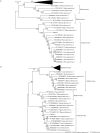Novel adenoviruses detected in British mustelids, including a unique Aviadenovirus in the tissues of pine martens (Martes martes)
- PMID: 28749327
- PMCID: PMC5817191
- DOI: 10.1099/jmm.0.000546
Novel adenoviruses detected in British mustelids, including a unique Aviadenovirus in the tissues of pine martens (Martes martes)
Abstract
Several adenoviruses are known to cause severe disease in veterinary species. Recent evidence suggests that canine adenovirus type 1 (CAV-1) persists in the tissues of healthy red foxes (Vulpes vulpes), which may be a source of infection for susceptible species. It was hypothesized that mustelids native to the UK, including pine martens (Martes martes) and Eurasian otters (Lutra lutra), may also be persistently infected with adenoviruses. Based on high-throughput sequencing and additional Sanger sequencing, a novel Aviadenovirus, tentatively named marten adenovirus type 1 (MAdV-1), was detected in pine marten tissues. The detection of an Aviadenovirus in mammalian tissue has not been reported previously. Two mastadenoviruses, tentatively designated marten adenovirus type 2 (MAdV-2) and lutrine adenovirus type 1 (LAdV-1), were also detected in tissues of pine martens and Eurasian otters, respectively. Apparently healthy free-ranging animals may be infected with uncharacterized adenoviruses with possible implications for translocation of wildlife.
Keywords: adenovirus; cross-species transmission; high-throughput sequencing; otter; pine marten.
Conflict of interest statement
The authors declare that there are no conflicts of interest.
Figures

Similar articles
-
Causes of mortality and morbidity in free-ranging mustelids in Switzerland: necropsy data from over 50 years of general health surveillance.BMC Vet Res. 2018 Jun 19;14(1):195. doi: 10.1186/s12917-018-1494-0. BMC Vet Res. 2018. PMID: 29921290 Free PMC article.
-
The Pine marten (Martes martes) and the Stone marten (Martes foina) as possible wild reservoirs of Toxoplasma gondii in the Baltic States.Vet Parasitol Reg Stud Reports. 2017 Aug;9:70-74. doi: 10.1016/j.vprsr.2017.05.004. Epub 2017 May 20. Vet Parasitol Reg Stud Reports. 2017. PMID: 31014846
-
Canine Distemper Virus in Wild Carnivore Populations from the Czech Republic (2012-2020): Occurrence, Geographical Distribution, and Phylogenetic Analysis.Life (Basel). 2022 Feb 15;12(2):289. doi: 10.3390/life12020289. Life (Basel). 2022. PMID: 35207575 Free PMC article.
-
Examining the uncertain origin and management role of martens on Prince of Wales Island, Alaska.Conserv Biol. 2015 Oct;29(5):1257-67. doi: 10.1111/cobi.12491. Epub 2015 Apr 8. Conserv Biol. 2015. PMID: 25855043 Review.
-
Polychlorinated biphenyls in the Eurasian otter (Lutra lutra).Rev Environ Contam Toxicol. 1998;157:95-130. doi: 10.1007/978-1-4612-0625-5_4. Rev Environ Contam Toxicol. 1998. PMID: 9666742 Review.
Cited by
-
A One-Year Retrospective Analysis of Viral and Parasitological Agents in Wildlife Animals Admitted to a First Aid Hospital.Animals (Basel). 2023 Mar 4;13(5):931. doi: 10.3390/ani13050931. Animals (Basel). 2023. PMID: 36899788 Free PMC article.
-
Opportunistic sampling of wild native and invasive birds reveals a rich diversity of adenoviruses in Australia.Virus Evol. 2020 May 10;6(1):veaa024. doi: 10.1093/ve/veaa024. eCollection 2020 Jan. Virus Evol. 2020. PMID: 32411389 Free PMC article.
-
Adenoviruses in Avian Hosts: Recent Discoveries Shed New Light on Adenovirus Diversity and Evolution.Viruses. 2022 Aug 13;14(8):1767. doi: 10.3390/v14081767. Viruses. 2022. PMID: 36016389 Free PMC article.
References
LinkOut - more resources
Full Text Sources
Other Literature Sources

